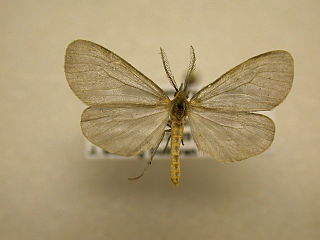
Pagara is a monotypic moth genus in the family Erebidae. Its only species, Pagara simplex, the mouse-colored lichen moth, is found in North America, where it has been recorded from Alabama, Arkansas, Florida, Georgia, Illinois, Indiana, Iowa, Kansas, Kentucky, Maryland, Mississippi, New Hampshire, North Carolina, Ohio, Oklahoma, South Carolina and Tennessee. Both the genus and species were described by Francis Walker in 1856.
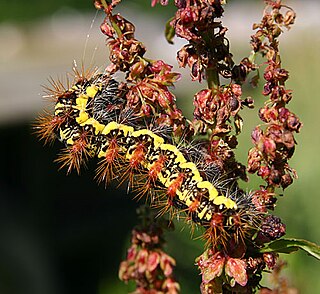
Acronicta oblinita, the smeared dagger moth or arioch dagger, is a moth of the family Noctuidae. Its larva, the smartweed caterpillar, has urticating hairs. The species was first described by James Edward Smith in 1797.
Geshna is a monotypic moth genus of the family Crambidae described by Harrison Gray Dyar Jr. in 1906. It contains only one species, Geshna cannalis, the lesser canna leafroller, described by Altus Lacy Quaintance in 1898. It is found in North America, where it has been recorded from Florida, Mississippi, South Carolina, North Carolina and Tennessee. It has also been recorded from Costa Rica and Cuba.
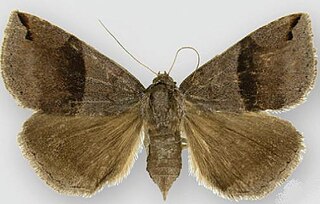
Gondysia similis, the gordonia darkwing is a moth of the family Noctuidae. The species was first described by Achille Guenée in 1852. It is found in the US from North Carolina to Mississippi and Florida. The food plant occurs in Alabama and Mississippi and the moth could be expected from these areas as well.

Macrochilo litophora, the angulate fan-foot or brown-lined owlet moth, is a litter moth of the family Erebidae. The species was first described by Augustus Radcliffe Grote in 1873. It is found in the United States from Wisconsin, east to Massachusetts, south to North Carolina, South Carolina, Mississippi and Texas.
Paraplatyptilia carolina is a moth of the family Pterophoridae described by William D. Kearfott in 1907. It is found in the southeastern United States, including Florida, southern Mississippi, North Carolina and Georgia.
Hellinsia lacteodactylus is a moth of the family Pterophoridae described by Vactor Tousey Chambers in 1873. It is found in North America, including Florida, Mississippi, Kentucky, North Carolina, Colorado, Nova Scotia and British Columbia.
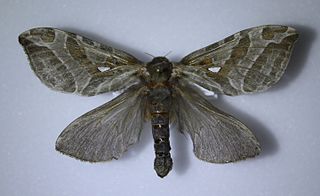
Sthenopis argenteomaculatus, the silver-spotted ghost moth, is a species of moth of the family Hepialidae. It was described by Thaddeus William Harris in 1841, and is known in North America from Nova Scotia to North Carolina and west to Minnesota.
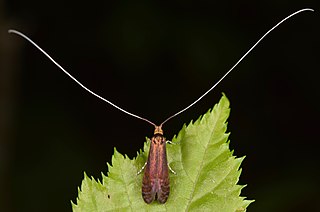
Adela caeruleella, the southern longhorn moth, is a moth of the family Adelidae or fairy longhorn moths. It was described by Francis Walker in 1863. It is found in North America, including Alabama, Arkansas, Florida, Illinois, Kentucky, Louisiana, Maryland, Mississippi, North Carolina, Ohio, Oklahoma, Pennsylvania, South Carolina, Tennessee, Texas, Virginia and West Virginia.

Schrankia macula, the black-spotted schrankia moth, is a moth of the family Erebidae. The species was first described by Herbert Druce in 1891. It is found from North America to Central America.
Crambidia pura, the pure lichen moth, is a moth of the family Erebidae. It was described by William Barnes and James Halliday McDunnough in 1913. It is found in North America, including Arizona, Florida, Georgia, Kentucky, Maryland, Mississippi, New Jersey, North Carolina, Ohio, Ontario, South Carolina, Tennessee, Texas and Wisconsin.
Prionoxystus piger, the baccharis carpenterworm moth, is a moth in the family Cossidae. It was described by Augustus Radcliffe Grote in 1865. It is found in Florida and Cuba.

Elophila gyralis, the waterlily borer moth, is a moth in the family Crambidae. It was described by George Duryea Hulst in 1886. It is found in eastern North America, where it has been recorded from Alabama, Florida, Georgia, Illinois, Indiana, Iowa, Louisiana, Maine, Maryland, Massachusetts, Michigan, Minnesota, Mississippi, New Brunswick, New Hampshire, New Jersey, New York, North Carolina, Nova Scotia, Ohio, Oklahoma, Ontario, Pennsylvania, Quebec, South Carolina, Tennessee, Texas and Wisconsin.
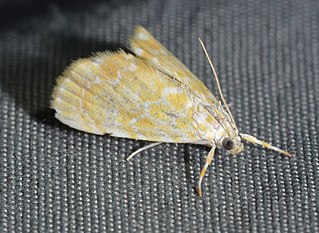
Glaphyria glaphyralis, the common glaphyria moth, is a moth in the family Crambidae. It was described by Achille Guenée in 1854. It is found in North America, where it has been recorded from Alabama, Arkansas, Florida, Georgia, Illinois, Indiana, Kentucky, Maryland, Massachusetts, Mississippi, Missouri, New Jersey, North Carolina, Ohio, Oklahoma, Ontario, Pennsylvania, South Carolina, Tennessee and West Virginia.

Diastictis argyralis, the white-spotted orange moth, is a moth in the family Crambidae. It was described by Jacob Hübner in 1818. It is found in North America, where it has been recorded from Colorado, Florida, Georgia, Indiana, Maine, Maryland, Mississippi, North Carolina, Ohio, Ontario, South Carolina, Tennessee, Texas and Virginia.
Diathrausta reconditalis, the recondite webworm moth, is a moth in the family Crambidae. It was described by Francis Walker in 1859. It is found in North America, where it has been recorded from Alabama, Arizona, Florida, Indiana, Kentucky, Maryland, Massachusetts, Mississippi, New Hampshire, New York, North Carolina, Ohio, Oklahoma, Ontario, South Carolina, Tennessee and West Virginia.

Dichorda iridaria, the showy emerald moth, is a moth of the family Geometridae. The species was first described by Achille Guenée in 1857. It is found in North America, where it has been recorded from Alabama, Arkansas, Florida, Georgia, Illinois, Indiana, Iowa, Kentucky, Maryland, Massachusetts, Mississippi, New Hampshire, New Jersey, New York, North Carolina, Ohio, Oklahoma, Ontario, Pennsylvania, Quebec, South Carolina, Tennessee, Texas, Virginia, West Virginia and Wisconsin.

Hyperstrotia secta, the black-patched graylet moth, is a moth of the family Erebidae. The species was first described by Augustus Radcliffe Grote in 1879. It is found in North America, where it has been recorded from Alabama, Arkansas, Florida, Georgia, Illinois, Indiana, Kentucky, Louisiana, Maryland, Massachusetts, Mississippi, New Hampshire, New Jersey, New York, North Carolina, Ohio, Oklahoma, South Carolina, Tennessee, Virginia and West Virginia.

Metalectra tantillus, the black fungus moth, is a moth of the family Erebidae. The species was first described by Augustus Radcliffe Grote in 1874. It has been recorded from the US states of Alabama, Florida, Georgia, Illinois, Iowa, Kentucky, Maryland, Mississippi, New Jersey, North Carolina, Ohio, Oklahoma, Pennsylvania, South Carolina, Tennessee, Texas, West Virginia and Wisconsin.
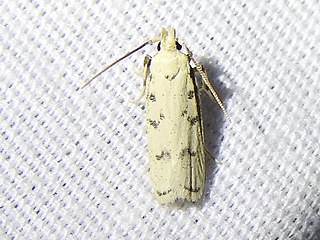
Glyphidocera lactiflosella, the five-spotted glyphidocera moth, is a moth in the family Autostichidae. It was described by Vactor Tousey Chambers in 1878. It is found in North America, where it has been recorded from Alabama, Arkansas, Florida, Georgia, Louisiana, Maine, Mississippi, North Carolina, South Carolina, Tennessee and Texas.













